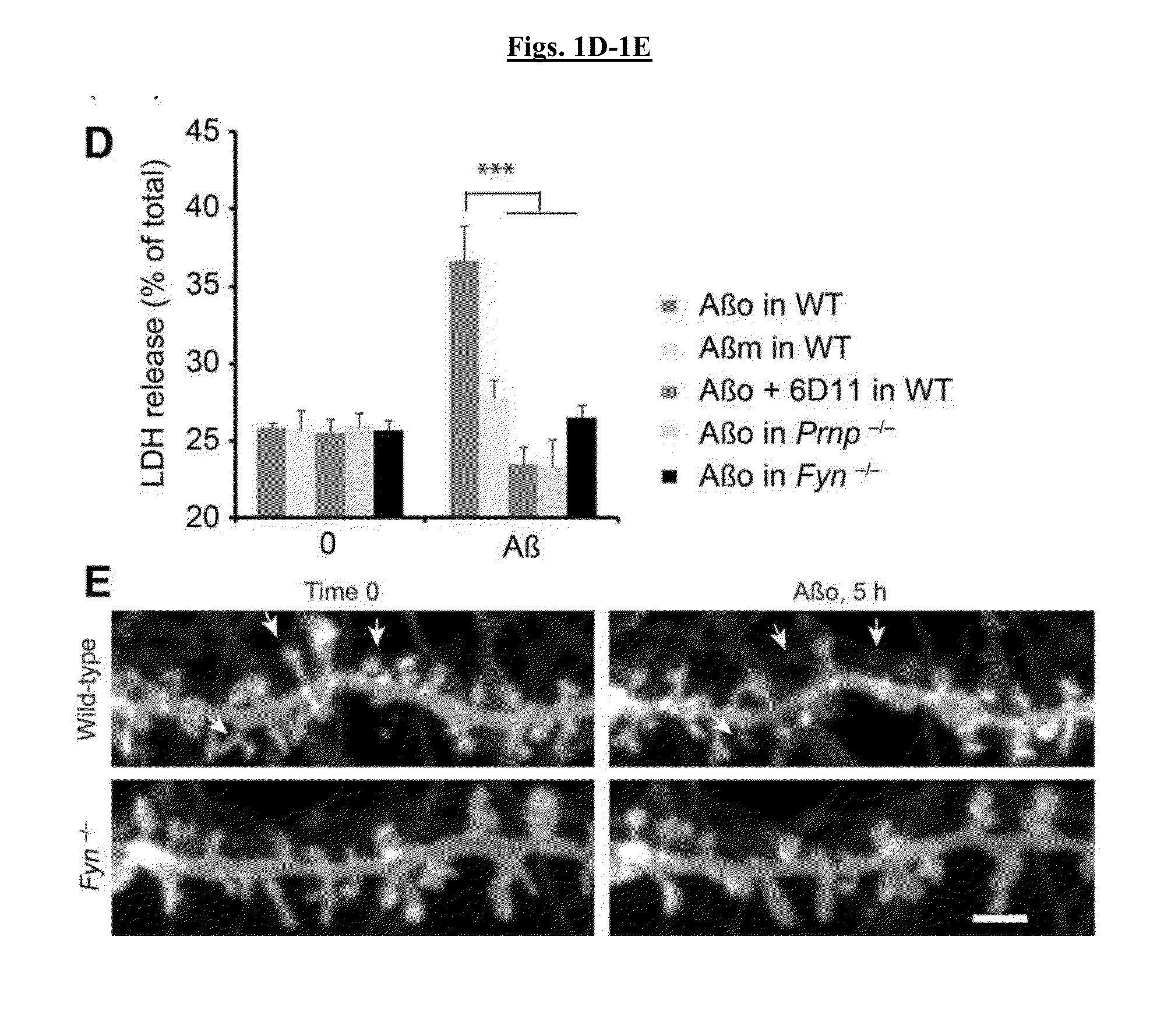Compositions and methods for treating a -modulated disease or disorder or improving cognition in a subject
a cognition and amodulation technology, applied in the field of cognition improvement, can solve the problems of no effective disease-modifying therapy today, no clinical trial successful targeting tau and/or tau kinases, and no current therapy modifies the course of ad, so as to improve cognition or prevent further loss.
- Summary
- Abstract
- Description
- Claims
- Application Information
AI Technical Summary
Benefits of technology
Problems solved by technology
Method used
Image
Examples
example 1
Pharmacological Inhibition of Fyn Kinase Inhibits Progression of AD
[0248]The studies presented herein were conducted to examine whether the pharmacological inhibition of Fyn kinase slows or halts the progression of AD.
Fyn Activation by Aβo-PrPC Alters Synaptic Function
[0249]Activation of Src family kinases (SFK) may be monitored by phosphospecific epitopes. Cultures were examined for SFK activation after exposure to Aβo (FIG. 1A). Wild type cortical neurons increased pY416-Fyn (SFK) in response to Aβo. The antibody used detects pY416 in several SFKs, but PrPC-dependent activation is Fyn-specific. In Prnp− / − cultures, activation of Fyn by Aβo was eliminated. It was also assessed whether these assemblies also activate neuronal Fyn. AD brain extracts at 6 μg protein / ml stimulated Fyn activation in mouse cortical cultures, but control brain extracts did not. Thus, TBS-soluble Aβ derived from human AD stimulates neuronal Fyn via PrPC.
[0250]NMDA-Rs play a key role in synaptic plasticity a...
example 2
Effect of a Fyn Inhibitor on Alzheimer's Disease Pathophysiology
[0261]To test the ability of saracatinib to treat learning and memory deficits caused by AD pathophysiology, WT and APPswe / PS1ΔE9 transgenic mice were treated with a Fyn inhibitor (saracatinib). The treatment was started when mice were 11-12 months of age. At this age, the transgenic mice generally have a pronounced learning and memory deficit. The dosing was on a twice a day schedule by oral gavage and control groups received vehicle. The identity of the active versus vehicle groups and the transgene status was unknown to the researchers handling the mice and collecting the behavioral data. Mice were treated with 0, 2 or 5 mg / kg / d of saracatinib. Both 2 and 5 mg / kg / d doses were tested against vehicle in a first cohort and then (because the initial results suggested that 5 mg / kg / d was required for benefit) a second cohort of mice was tested with 0 versus 5 mg / kg / d. The data from the two cohorts were pooled. Different te...
example 3
Clinical Studies
[0269]A Phase Ib multiple ascending dose study of saracatinib was completed using 24 subjects with mild to moderate AD. Subjects were enrolled in three cohorts of 8 subjects each. Each cohort consisted of subjects receiving saracatinib (n=6) or placebo (n=2) PO daily. Daily, the first cohort received 50 mg saracatinib free base (71.4 mg saracatinib difumarate), the second 100 mg (142.9 mg saracatinib difumarate) and the third 125 mg (178.6 mg saracatinib difumarate).
[0270]There were no apparent study-related serious adverse events (SAEs), significant laboratory abnormalities, or early terminations. In particular, there were no significant hematological changes.
[0271]Beyond safety and tolerability, the Phase 1b collected both CSF and plasma for saracatinib levels, and obtained FDG-PET scans at the start and end of the treatment period. In certain embodiments, obtaining the scans worked as a pilot to the collection of brain metabolism data for the Phase 2a trial. In ad...
PUM
| Property | Measurement | Unit |
|---|---|---|
| time | aaaaa | aaaaa |
| time | aaaaa | aaaaa |
| time | aaaaa | aaaaa |
Abstract
Description
Claims
Application Information
 Login to View More
Login to View More - R&D
- Intellectual Property
- Life Sciences
- Materials
- Tech Scout
- Unparalleled Data Quality
- Higher Quality Content
- 60% Fewer Hallucinations
Browse by: Latest US Patents, China's latest patents, Technical Efficacy Thesaurus, Application Domain, Technology Topic, Popular Technical Reports.
© 2025 PatSnap. All rights reserved.Legal|Privacy policy|Modern Slavery Act Transparency Statement|Sitemap|About US| Contact US: help@patsnap.com



